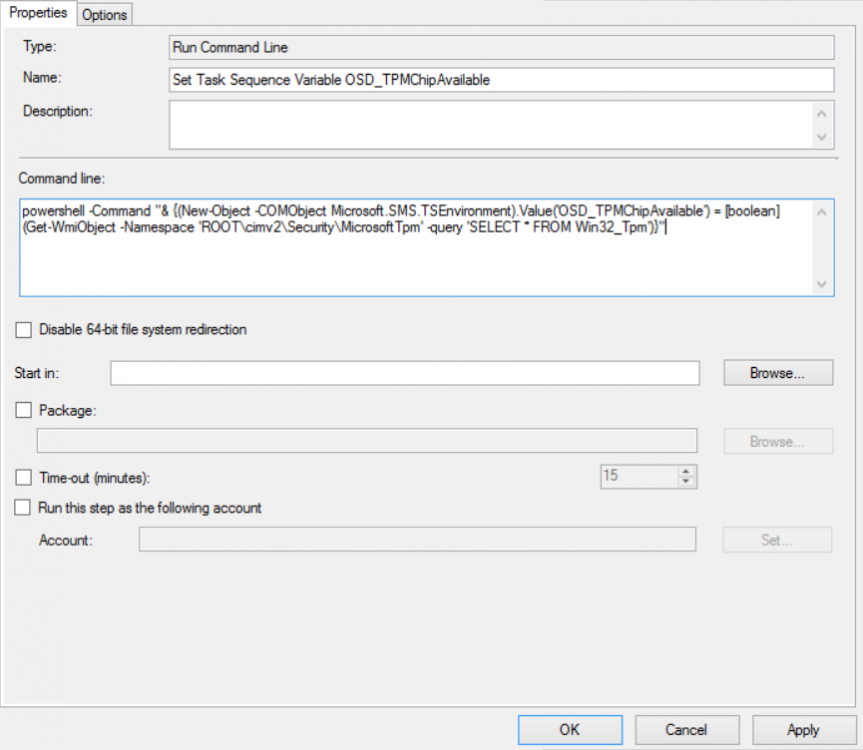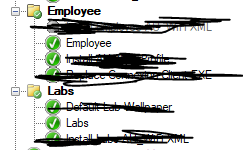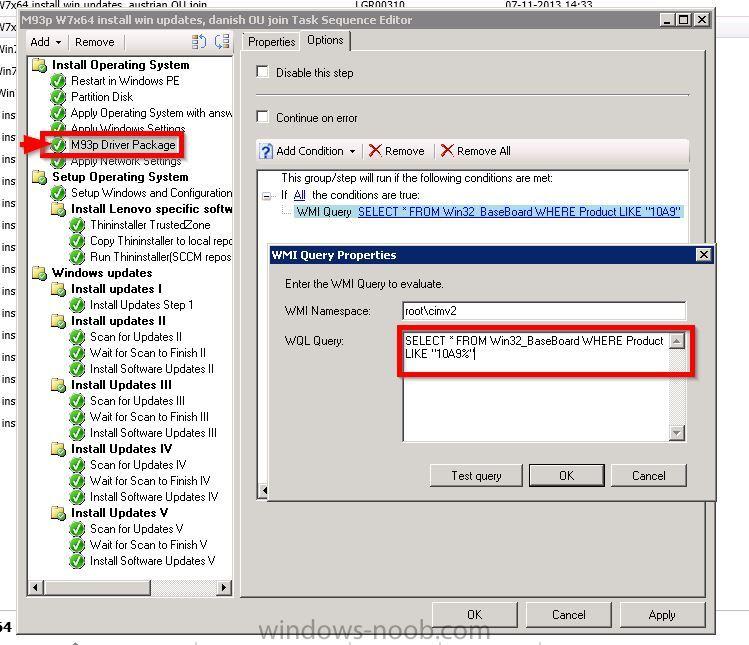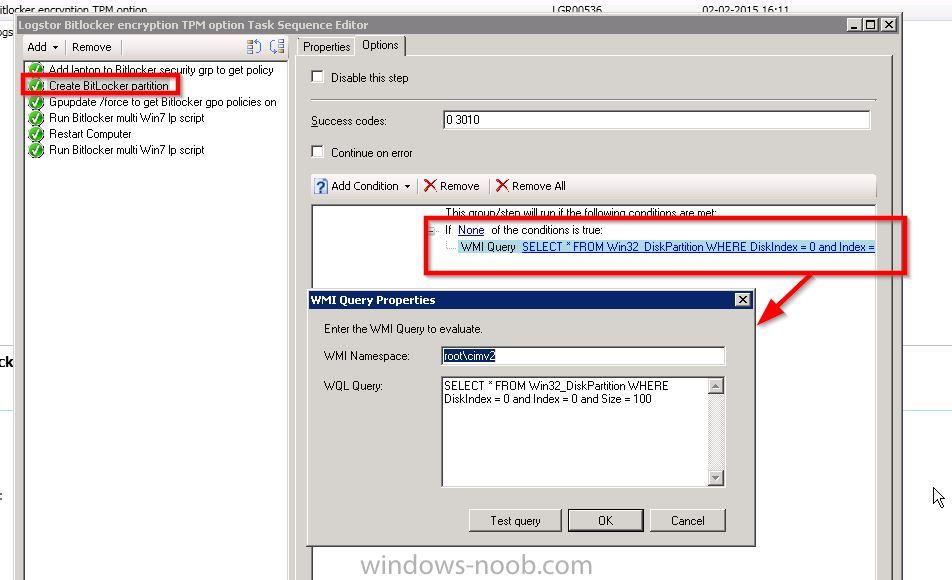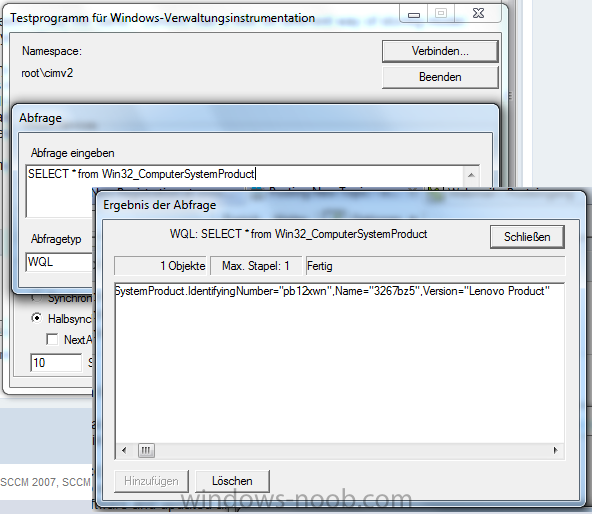Search the Community
Showing results for tags 'wmi'.
-
OSD Run Command Line: WMI to TS Variable
jHetzer posted a question in Troubleshooting, Tools, Hints and Tips
OSD Run Command Line: WMI to TS Variable (Tested with WinPE 1703 and Windows 10 1703 / SCCM 2012 Version 1706 / MDT ) A short guide how to store WMI information into a Task Sequence Variable without the need of a script. (And therefore without a "Update Distribution Point") Create a new "Run Command Line" Step Set the step name for example: "Set Task Sequence Variable OSD_VariableName" Command Line: powershell -Command "& {(New-Object -COMObject Microsoft.SMS.TSEnvironment).Value('OSD_VariableName') = (Get-WmiObject Win32_ComputerSystemProduct).Version}" Done The example shows how to store the property "Version" of the WMI Class "Win32_ComputerSystemProduct" into the Variable "OSD_VariableName". This is for example usefully for Lenovo devices because the property holds the real model name (Lenovo Model Names) and not the cryptic ID which may change. Other examples would be: Device Disk Count: powershell -Command "& {(New-Object -COMObject Microsoft.SMS.TSEnvironment).Value('OSD_DiskCount') = @(Get-WmiObject -query 'Select * from Win32_DiskDrive WHERE MediaType = \"Fixed hard disk media\"').Count}" Device TPM Chip Available: powershell -Command "& {(New-Object -COMObject Microsoft.SMS.TSEnvironment).Value('OSD_TPMChipAvailable') = [boolean](Get-WmiObject -Namespace 'ROOT\cimv2\Security\MicrosoftTpm' -query 'SELECT * FROM Win32_Tpm')}" Event more complicated commands are possible but at some point a script provides more flexibility. Important Note: "Run Command Line" step in conjunction with "powershell -Command "& {Crazy-PowershellFunction}" has problems with double quotes ("). If they are required they need to be escaped with "\". See for example: Device Disk Count: Other special characters my produce similar issues. If you like this quick and simple solution and found some other useful commands please share them in a reply to this Topic- 1 reply
-
- variable
- tasksequence
-
(and 4 more)
Tagged with:
-
Hi Everyone,
I'm a new Level 2 Technician as i was previously Level 1 technician and my main role was helping users troubleshoot issues on their Computer and recently had a few colleagues from Level 3 started helping me get into SCCM environment were i flourishing from their Wisdom, so found your site and started to visit this site to learn a few things and decided to register.
Thank you for visiting my page
-
Hello, I have the problem with my SCCM that I cannot open the Administration Console anymore. The last think I have do bevor it don't works anymore was to fix my 0% downloading from Software Center Problem. I have tried these steps from Arthur_Li (because the fix with the .mof files don't work for me): https://social.technet.microsoft.com/Forums/windows/en-US/df00b2e4-3bab-4b46-ad5a-95e82617a039/wmi-errors?forum=winserverNIS Here are the SMSAdmin Logs: [19, PID:1928][10/11/2018 08:50:07] :Transport error; failed to connect, message: 'The SMS Provider reported an error.'\r\nMicrosoft.ConfigurationManagement.ManagementProvider.WqlQueryEngine.WqlQueryException\r\nThe SMS Provider reported an error.\r\n at Microsoft.ConfigurationManagement.ManagementProvider.WqlQueryEngine.WqlQueryResultsObject.<GetEnumerator>d__74.MoveNext() [19, PID:1928][10/11/2018 08:50:07] :Transport error; failed to connect, message: 'The SMS Provider reported an error.'\r\nMicrosoft.ConfigurationManagement.ManagementProvider.WqlQueryEngine.WqlQueryException\r\nThe SMS Provider reported an error.\r\n at Microsoft.ConfigurationManagement.ManagementProvider.WqlQueryEngine.WqlQueryResultsObject.<GetEnumerator>d__74.MoveNext() at Microsoft.ConfigurationManagement.AdminConsole.SmsSiteConnectionNode.GetConnectionManagerInstance(String connectionManagerInstance)\r\nConfigMgr Error Object: instance of __ExtendedStatus{Operation = "ExecQuery";ParameterInfo = "SELECT * FROM SMS_Site WHERE SiteCode = 'PS0'";ProviderName = "WinMgmt"; } Error Code: ProviderLoadFailure [19, PID:1928][10/11/2018 08:50:07] :Transport error; failed to connect, message: 'The SMS Provider reported an error.'\r\nMicrosoft.ConfigurationManagement.ManagementProvider.WqlQueryEngine.WqlQueryException\r\nThe SMS Provider reported an error.\r\n at Microsoft.ConfigurationManagement.ManagementProvider.WqlQueryEngine.WqlQueryResultsObject.<GetEnumerator>d__74.MoveNext() I have tried to reinstall the console with the AdminConsole.msi but this don't work. Also I have tried to connect with my IP, but also no success. The complete D drive where SCCM is installed, the SMSAdmins Group has "Full control" permissions. At this group are all user where can connected to the server and the server itself. All sms services are running. One think I found out is that my wmi maybe don't work right. At another Topic (https://www.windows-noob.com/forums/topic/10298-applications-suddenly-wont-deploy-hung-stuck-at-0-downloading/) they tried "Run the query select * from sms_sci_component where componentname=SMS_DISTRIBUTION_MANAGER" to fix the wmi problem, but if I try this query I get the following error: Number: 0x80041017Facility: WMIDescription: Invalid query Could it be that this query is only for 2012? At the wmiprov.log I get this error by trying to open the Console from SCCM: (Wed Oct 10 10:16:42 2018.780762406) : WDM call returned error: 5 The WMIDIAG Log is attach below WMIDIAG-V2.2_2K12R2.SRV.RTM.64_SRV-SCCM_2018.10.12_09.52.41-REPORT.TXT
-
So, I have a few custom groups in my task sequence that install applications based upon some WMI queries using a naming convention. But I am having some issues trying to get it working exactly. Here is what I am trying to do. I have two groups. Employee and Labs. The naming convention for employees is LIB-AU and for the Labs its LIB-AUXXXXX-XX where the X's represent numbers I have this particular "If" statement. Here is the query in question that I currently have for employee SELECT * FROM Win32_ComputerSystem WHERE Not Name LIKE 'LIB-AU%-%' Here is the query for the labs group. SELECT * FROM Win32_ComputerSystem WHERE Name LIKE 'LIB-AU%-%' The behavior that occurs is that everything under the employees group installs to a system if it has the name "LIB-AUXXXXX-XX" - I don't want this to happen. I only want it to run the steps if it meets the 'LIB-AUXXXXX' naming, but otherwise skip it. The query for the "labs" group works fine. Any suggestions?
-
Hi all, So we are in the process of switching to Configuration Manager 2012 and we are now having MANY instances of WMI corruption on user workstations. The OS we are deploying is Win 7 SP1. Symptoms: -Keeping users from logging in (heavily delayed or not at all), spinning at the blue login screen. -Computer hangs at logoff/shutdown. -NIC lags on recognizing internet connection at startup. -Programs running slow and crashing (Includes MS Office and IE). -Windows crashing and getting black screens. Fixes we've tried: -Deleting all expired updates from Configuration Manager. -Consolidating software update groups. When originally installed, someone configured it so every update would create it's own update group. After fixing this, we saw a decrease in affected machines. -Reseting the repositroy. This is pretty much putting a band-aid on the problem. It get's users to be able to get functional again while we continue to troubleshoot the underlying problem. We've tried salavaging the repository, but it hardly if ever completes successfully. -Applying the following hotfixes from Microsoft, after the repository has been reset. This method is only on about 1% of the machines on our network and is still in testing phase. 2705357 The WMI process stops sending events to WMI clients from a Windows 7-based or Windows Server 2008 R2-based server 2692929 "0x80041001" error when the Win32_Environment WMI class is queried by multiple requestors in Windows 7 or in Windows Server 2008 R2 2617858 Unexpectedly slow startup or logon process in Windows Server 2008 R2 or in Windows 7 2465990 "0x80041002 (WBEM_E_NOT_FOUND)" error occurs when you try to open a WMI namespace on a computer that is running Windows 7 or Windows Server 2008 R2 2492536 Msinfo32.exe takes a long time to display or export system information on a computer that has many MSI-X-supported devices and that is running Windows 7 or Windows Server 2008 R2 2578159-When you log on to a computer that is running Windows Server 2008 R2 or Windows 7, the logon process stops responding and a blue swirl is shown on the Welcome screen indefinitely. After some time, the computer stops responding to any network-related commands. You must forcibly restart the computer to recover from this issue. This issue occurs because of a race condition between the Windows Event Log service and the Event Tracing for Windows (ETW) tracing functions. When the race condition occurs, it causes a deadlock situation. This deadlock situation then causes the Winlogon.exe process to become unresponsive. 2639505- Assume that you run a service which queries the Win32_StartupCommand Windows Management Instrumentation (WMI) class on a computer that is running Windows Vista, Windows Server 2008, Windows 7, or Windows Server 2008 R2. In this situation, all loaded user profiles occasionally cannot be unloaded successfully after the WMI query is finished. If the number of unloaded user profiles keeps increasing, the system resources may be exhausted. For example, the virtual address control block (VACB) may be exhausted. 2639077-Handle leak in Svchost.exe when a WMI query is triggered by using the Win32_PowerSettingCapabilities class in Windows 7 or in Windows Server 2008 R2 2547244-The WMI service and the WMI providers stop responding when you use WMI performance classes to monitor performance on a computer that is running Windows 7 or Windows Server 2008 R2 Thanks in advance for any help!
- 6 replies
-
- Configuration Manager 2012
- SCCM 2012
- (and 8 more)
-
Hello Everyone. I am trying to integrate SCCM 2012 R2 with MBAM 2.5 But I have problem with importing BitLocker Policy (Win32Reg_MBAMPolicy) When I run mofcomp against sms_def.mof C:\Users\scwi\Desktop>mofcomp mbam.mof Microsoft ® MOF Compiler Version 6.3.9600.16384 Copyright © Microsoft Corp. 1997-2006. All rights reserved. Parsing MOF file: mbam.mof MOF file has been successfully parsed Storing data in the repository... An error occurred while creating object 2 defined on lines 10 - 42: 0X80041002 Class, instance, or property 'SMS_Class_Template' was not found. Compiler returned error 0x80041002 Ok so I queried my WMI and I do have that class. It has to be there since I successfully importerd BitLocker Encryption Details (Win32_BitLockerEncryptionDetails) all the MOF files I got I have from MS websites below. https://technet.microsoft.com/en-us/library/dn645321.aspx https://technet.microsoft.com/en-us/library/dn656927.aspx I was able to import - Computer System Ex - Operating System Ex - Win32_BitLockerEncryptionDetails) when I removed this portion from the script: #pragma namespace ("\\\\.\\root\\cimv2\\SMS") #pragma deleteclass("Win32Reg_MBAMPolicy", NOFAIL) [ SMS_Report(TRUE), SMS_Group_Name("BitLocker Policy"), SMS_Class_ID("MICROSOFT|MBAM_POLICY|1.0")] Class Win32Reg_MBAMPolicy: SMS_Class_Template { [sMS_Report(TRUE),key] string KeyName; //General encryption requirements [sMS_Report(TRUE)] UInt32 OsDriveEncryption; [ SMS_Report (TRUE) ] UInt32 FixedDataDriveEncryption; [ SMS_Report (TRUE) ] UInt32 EncryptionMethod; //Required protectors properties [ SMS_Report (TRUE) ] UInt32 OsDriveProtector; [ SMS_Report (TRUE) ] UInt32 FixedDataDriveAutoUnlock; [ SMS_Report (TRUE) ] UInt32 FixedDataDrivePassphrase; //MBAM Agent fields //Policy not enforced (0), enforced (1), pending user exemption request (2) or exempted user (3) [sMS_Report(TRUE)] Uint32 MBAMPolicyEnforced; [sMS_Report(TRUE)] string LastConsoleUser; //Date of the exemption request of the last logged on user, //or the first date the exemption was granted to him on this machine. [sMS_Report(TRUE)] datetime UserExemptionDate; //Errors encountered by MBAM agent. [ SMS_Report (TRUE) ] UInt32 MBAMMachineError; [ SMS_Report (TRUE) ] string EncodedComputerName; }; I tried to integrate MBAM and sccm but I am getting this error : Unexpected Configurator error. Description: Exception thrown from feature provider. Exception: System.NullReferenceException: Object reference not set to an instance of an object. at Microsoft.ConfigurationManagement.ManagementProvider.WqlQueryEngine.WqlResultObjectBase.get_Item(String name) at Microsoft.Mbam.Setup.Common.CmIntegration.SmsEntities.SmsCollection.get_CollectionId() at Microsoft.Mbam.Setup.Common.CmIntegration.Implementors.CmObjectsManager.TryDeleteInvalidCollection(ISmsCollection collection) at Microsoft.Mbam.Setup.Common.CmIntegration.Implementors.CmObjectsManager.CreateAndInitializeCollection[T,U](T collectionSettings, Boolean& updated, ISmsCollection& collectionBeforeUpdate) at Microsoft.Mbam.Setup.Common.CmIntegration.Implementors.CmObjectsManager.CreateCollection(String collectionSettingsFilePath, CultureInfo desiredCulture, CMVersion cmVersion, Boolean& updated, ISmsCollection& collectionBeforeUpdate) at Microsoft.Mbam.Setup.Common.CmIntegration.CMObjects.CreateCmCollections() at Microsoft.Mbam.Setup.Common.ActionItem.Run() at Microsoft.Mbam.Setup.Common.ActionItemQueue.Run() at Microsoft.Mbam.Setup.Common.CmIntegration.CmIntegrationProvider.Enable(IProgress`1 progress, CancellationToken cancellationToken, CmIntegrationConfiguration configuration) at Microsoft.Mbam.Setup.Common.FeatureProviderBase`1.<>c__DisplayClass34`1.<InvokeAsync>b__33() at System.Threading.Tasks.Task`1.InnerInvoke() at System.Threading.Tasks.Task.Execute() --- End of stack trace from previous location where exception was thrown --- at System.Runtime.CompilerServices.TaskAwaiter.ThrowForNonSuccess(Task task) at System.Runtime.CompilerServices.TaskAwaiter.HandleNonSuccessAndDebuggerNotification(Task task) at Microsoft.Mbam.Setup.Common.FeatureProviderBase`1.<InvokeAsync>d__36`1.MoveNext() --- End of stack trace from previous location where exception was thrown --- at System.Runtime.CompilerServices.TaskAwaiter.ThrowForNonSuccess(Task task) at System.Runtime.CompilerServices.TaskAwaiter.HandleNonSuccessAndDebuggerNotification(Task task) at Microsoft.Mbam.Setup.Common.FeatureProviderBase`1.<>c__DisplayClass2.<<EnableAsync>b__0>d__4.MoveNext() --- End of stack trace from previous location where exception was thrown --- at System.Runtime.CompilerServices.TaskAwaiter.ThrowForNonSuccess(Task task) at System.Runtime.CompilerServices.TaskAwaiter.HandleNonSuccessAndDebuggerNotification(Task task) at System.Runtime.CompilerServices.ConfiguredTaskAwaitable`1.ConfiguredTaskAwaiter.GetResult() at Microsoft.Mbam.Setup.Common.FeatureProviderBase`1.<EnableAsync>d__8.MoveNext() --- End of stack trace from previous location where exception was thrown --- at System.Runtime.CompilerServices.TaskAwaiter.ThrowForNonSuccess(Task task) at System.Runtime.CompilerServices.TaskAwaiter.HandleNonSuccessAndDebuggerNotification(Task task) at Microsoft.Mbam.Setup.Configurator.CMUIFeatureModel.<EnableTransacted>d__4.MoveNext() --- End of stack trace from previous location where exception was thrown --- at System.Runtime.CompilerServices.TaskAwaiter.ThrowForNonSuccess(Task task) at System.Runtime.CompilerServices.TaskAwaiter.HandleNonSuccessAndDebuggerNotification(Task task) at Microsoft.Mbam.Setup.Configurator.BatchTaskModel.<>c__DisplayClass5.<<Commit>b__1>d__7.MoveNext() I am assuming it is because I don't have BitLocker Policy imported to my default client inventory because MBAM 2.5 Integration wizard creates device collection MBAM managed devices . It feels like I tried everything but I know I don't so I decided to ask all the generous people to help me here.
-
This may be a stupid question but I am trying to determine how to test WMI Queries in SCCM. Example: I want to target Driver Packages for Make/Model in OSD Task Sequences I read several forums on how to set them in a TS but I would like to confirm the query is correct by pulling results from the SCCM DB if that is possible. Perhaps I need to run it on the machines themselves in WBEMTEST.exe Could anyone point me in the right direction on how to accomplish? I greatly appreciate it!
-
Hi, Our current Task sequence for the Surface pro devices has been working great for sometime. Now with our entity moving towards Windows 10, I'd like to just add on the driver package step in my task sequence to get the needed driver package at it's desired OS. Currently, I have one driver package for Surface devices with all drivers and firmware as shown in the tutorials provided from here. My current WMI query for identifying the device is the basic " Select * From Win32_ComputerSystem WHERE Model LIKE "%Surface Pro 3% " Which works fine for when you have two different generations of Surface Pro devices. With our WIn10 migration coming up, I've gone ahead and imported the Win 10 driver package into SCCM, but I need to find a find a better way to query the two different driver packs. Otherwise the TS will install both packages to the system, defeating the whole point... So, my question is- What is the best way to query the driver packages for the same device but each being guided at a different OS? (we need to keep both packages present for the time being) By OS? - with the builds of windows 10 changing every 8 months, how will this(if at all) affect my query? Any suggestions or wake up calls is always appreciated!
- 2 replies
-
- Driver packages
- Query
-
(and 1 more)
Tagged with:
-
I am attempting to write a powershell script for our 2012 SP1 environment that well ask for the input of a package ID and it will prestage its dependencies all in separate pkgx files so it is easier to tell what has already been pre-staged. Each dependency will be named by package ID. I have the logic to get the dependencies, however I noticed something. If I go to prestage a file and check the box to include dependencies, it will list the superseded packages as well. If I try to distribute content, it will only list the dependencies. While researching superscedence and content issues, I have discovered that if it is deployed via Task Sequence, it will download the supersceded application as well. So this then changes the need for my script, I now need a way to determine what applications an application supersedes through a WMI or SQL query. Does anyone have any idea where to find that? I am attempting to find it in the DBprov log now, but I was hoping someone might have that info already available.
- 1 reply
-
- SCCM
- Configuration Manager
-
(and 3 more)
Tagged with:
-
Hi, Does anyone know where to pull info like an error from Windows Update? I want to make a SCCM-collection based on computers that get a specific error in Windows Update. Appreciate the help guys
-
- windows update error
- collection
-
(and 2 more)
Tagged with:
-
Hi I still have problems with deploying Bitlocker in our environment (on laptops that don't need / haven't been reinstalled through SCCM yet) We switched to SCCM from Altiris around 2 years ago, the laptops that were installed through Altiris were setup with 2 partitions and the ones installed through SCCM I only installed Win7 Ent on 1 partition. See attached screenshots. Any ideas on the error message in the smsts.log file from the Altiris laptop (the one I have marked with a green square)?
-
- wmi
- task sequence
-
(and 1 more)
Tagged with:
-
We pushed Endpoint out to our campus clients within the last month and all has been good. The SCEP client is being pushed through Client Settings. We recently re-imaged a couple machines using OS deployment and would expect that SCCM would see them as a not having the SCEP client and go ahead and install it again. However, we are getting the following messages in the EnpointProtectionAgent.log file and they repeat every 25 minutes or so: Service startup notification received EndpointProtectionAgent 7/28/2014 1:25:33 PM 2572 (0x0A0C) Endpoint is triggered by CCMTask Execute. EndpointProtectionAgent 7/28/2014 1:25:33 PM 2456 (0x0998) Deployment WMI is NOT ready. EndpointProtectionAgent 7/28/2014 1:25:33 PM 2456 (0x0998) From what I can gather SCCM still thinks the SCEP client is managed since it shows managed in the ConifgMan console, so this is causing it not to push the client again. Something is cached somewhere and is not letting the install to proceed. Any thoughts?
-
I have 5 sites that currently have 5 separate, identical task sequence...but one difference is there is a program one of my techs wrote that renames the computer to, for example, MPHS-SerialNumber. Our sites are as follows: MPHS- MPJH- MPES- so forth and so on Each site has their own gateway/subnet, and so if I was able to put this ALL into ONE task sequence that would be amazing. If given this, how would you all do this? I know that I can add the scripting/program/etc for each site to the task sequence, and then under options apply a conditional WMI query based on the subnet/gateway the client resides in, but I don't know HOW to do this. I've tried this: Select * From Win32_NetworkAdapterConfiguration Where DefaultIPGateway="10.80.16.1" And I get this error during the task sequence: The task sequence execution engine failed evaluating the condition for the action (MPHS Rename) in the group (Site-Specific Renaming). Error code 4119. The operating system reported error 53: The network path was not found. I'm at a loss for how to achieve this, but i know it's something simple i'm missing...or I just need to completely re-evalute how we're renaming these computers and do it differently...anyone out there generous enough to help me out with this task would be greatly appreciated! Thanks so much!
- 10 replies
-
Installation of the DP went fine. The logs show that everything worked fine. The SCCM folders were created. The DP server shows up in the console. Trying to distribute content to the new DP fails with the following errors: ERROR DPConnection::ConnectWMI() - Failed to connect to Office-DP.domain.com. error = 0x800706ba Cannot establish connection to ["Display=\\Office-DP.domain.com\"]MSWNET:["SMS_SITE=TSM"]\\Office-DP.domain.com\. Error = 53 Failed to make a network connection to \\Office-DP.domain.com\ADMIN$ (0x35) CWmi::Connect() failed to connect to \\Office-DP.domain.com\root\MicrosoftIISv2. Error = 0x800706BA The Site server is local admin on the machine. From the site server I can open \\Office-DP\Admin$ , and D$ (SCCM drive) and create folders and copy data. From the link below, I thought maybe the WMI namespace for SCCMPD was not created on the DP, so I ran mofcomp.exe smsdpprov.mof to create it http://silentcrash.com/2013/09/error-0x800706ba-when-trying-to-install-new-distribution-point-in-sccm-2012-sp1/ What am I missing? Thinking it was a problem with this location, I setup another DP in a different location and am having the same issue with it. I think I must be missing a step somewhere, but can't for the life of me think what it might be. Thank you, LT.Son
- 3 replies
-
- Distribution Point
- Error
-
(and 1 more)
Tagged with:
-
Hi All, I really hope someone can help me with this sudden problem I'm experiencing. I'm trying to deploy a TS on some Dell Optiplex 320s and the TS is *suddenly* failing. It fails at the point of installing applications, installing the first two and then failing on the rest. I know the wim is fine because I've used the same one for deploying to other machines and it works fine. The logs point to an issue with WMI with entries such as An extract of the log file is below: Should I run a command before the application install task to clear/reset the repository or has anyone got any other ideas? Thanks in advance
-
Good morning, I have printers set for inventory on my SCCM 2012 environment. I need to run a query on all USB/LPT connected printers in the district. Can someone please help me with a query/report or something that I can run that will give me a list of all printer models that have been collected from all my clients? This will help me in collecting drivers while we go forward with our district-wide windows 7 migrations. Many thanks!
-
Hi. Edit 5. I have created the same thread at forums.lenovo.com as they may have more insight into this matter. Anyway, it seems that my ThinkCentre has forgotten who he is. I have a ThinkCentre M72e (3267-BZ5). I deployed Win7 ENT x64 and tried to install driver packages with conditions. I have googled quite a bit and most sites seem to say the same. "Lenovo has a little bit different way of storing model type, it can be found in Win32_ComputerSystemProduct.Version... But those conditions failed, none were matched. After I got the target computer up and running, I checked and the computer has the following property values in Win32_ComputerSystemProduct: Win32_ComputerSystemProduct.IdentifyingNumber="pb12xwn" Win32_ComputerSystemProduct.Name="3267-BZ5" Win32_ComputerSystemProduct.Version="Lenovo Computer" All other properties in Win32_ComputerSystemProduct are NULL Additonal info: For now I did not copy all the ThinkCentre drivers into my driver store but only those that were needed because Windows 7 media would not identify those devices. So some chipset drivers may be windows generic and not from the manufacturers. BUT after the OSD I have - installed Lenovo software and updated all drivers and rebooted - no change - updated BIOS also (chose NOT to manually update the model name - no change and the WMI query still returns the same result as above. I am a little lost at where to go next, as in my mind this information should be somewhere in the computer hardware? Cheers. -MPT-
-
Hi, I have to modify a distribution point value with powershell script. The value is PrestageAllowed who locate in wmi class SMS_SCI_SYSRESUSE like screenshot http://imageshack.us/photo/my-images/27/sanstitrewi.png/ Thanks fz
- 1 reply
-
- SCCM
- powershell
-
(and 4 more)
Tagged with:
-
Hi All Could anybody help me to solve my issue? I need to create TS which 1. Deinstall old soft 2. Install new version The problem is that I need to be sure that there is at least 1 GB avalible disk space on C drive before 1 task starts. I know that I could use WMI query but Im not sure how exactely the WQL Query should look like. Thanks for any help provided Greg
- 1 reply
-
- Task Sequence
- Condition
-
(and 2 more)
Tagged with:
-
Hi Guys and Gals, Hope this finds you all well, and having a great start to 2013. I had a quick search of the forums, and didnt find anything related Also hit google / bing and found nearly what i am after. I thought I would ask here as someone is bound to have done what i am trying to achieve. I would like to set a condition on some software in my sccm 2012 task sequence to only deploy certain apps if the client is a laptop, and only install some others if it is a desktop. Thus a single task sequence with a bit of logic. At the moment i have 2 task sequences one for laptops and one for desktops. - This is fine, just wanted to know how to do it really. I have located the codes for the chassis type / system enclosure, and locally on my box, have been able to return the chassis type / enclosure type via wmi. I have also seen this is alot easier if you integrate mdt 2012 and use the ISLAPTOP, ISDESKTOP, IS SERVER env vars. I have also seen the "check to see if has a battery >0" example somewhere on google. Using chass/enclosure as the condition is better than battery>0 HOWEVER.... how easy is it to do the same thing without installing MDT I was thinking wmi, but cant seem to get my command prompt syntax to be valid within sccm. Has anyone done this or similar before ? And if so - could you point me in any direction. As always, any help is really appreciated, Thanks and regards, WAZZIE


